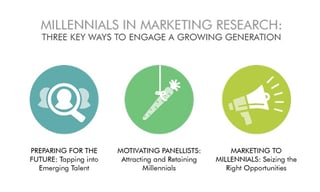Millennials now represent the largest segment in the workforce today surpassing GenXers and Baby Boomers. With this growing pool of talent, we need to step back and look at the marketing research industry. Millennials are known to be tech savvy, social media connected and diverse in their skills, but are we fully tapping into this generation to evolve?
By asking ourselves three key questions, we can start to move forward and identify strong behaviors to build essential bridges with millennials.
- How are we tapping into emerging talent to develop the next generation of marketing research leadership?
- What is our strategy to attract and retain millennials on our panels?
- What challenges do we see in engaging millennials? What opportunities do we see with this generation?
I believe this is the year of creating new value – for our panellists, for our clients and for our talent. We are now in the world of unconventional partnerships, so why not re-write the marketing research rule book?
Preparing for the Future: Tapping into Emerging Talent
It’s clear that millennials are a powerful generation with distinct values and workforce expectations. For millennials coming into the workforce today, the technology that we think as being the latest for business is actually the technology they have been using every day. Either through their school and university education, communicating with friends and developing their own apps; they are completely immersed in it. That means letting our talent lead with their ideas around technology and development, to bring forth suggestions, innovations and applications. We need to exploit the skills of our emerging talent to grow our industry in the right direction.
Motivating Panellists: Attracting and Retaining Millennials
Surveys are a single touchpoint, but the consumer journey is changing. To attract and retain millennials, we need to make the experience a two-way conversation by trying to give back information and knowledge in a trading/bartering system for the research insights we gain. At a softer level, we need to ensure the survey environment mirrors the apps and communities that millennials reside in. Having said that, the greatest challenge is the way the research community is engaging with millennials. If we turn them away unnecessarily, we are reducing our opportunity to glean responses from them. We need to not only adopt a customer centric approach, but we need to capture data that is insightful, not invasive to retain millennials.
Marketing to Millennials: Seizing the Right Opportunities
Across marketing research, we need to move from the now to the next. Traditional marketing has always been a one-way push to consumers: advertising through newspapers, magazines, telephone books, radio, and TV. Marketing today has shifted to an attribution model, requiring a responsive design.
Manage data like a product: understand what millennials and consumers want from a company or brand and then respond in a relevant fashion. To seize the right opportunities, automation is key. We need to be fast, engaging, multi-channel and easily accessible. We need to think big, act small and personalize the experience.




